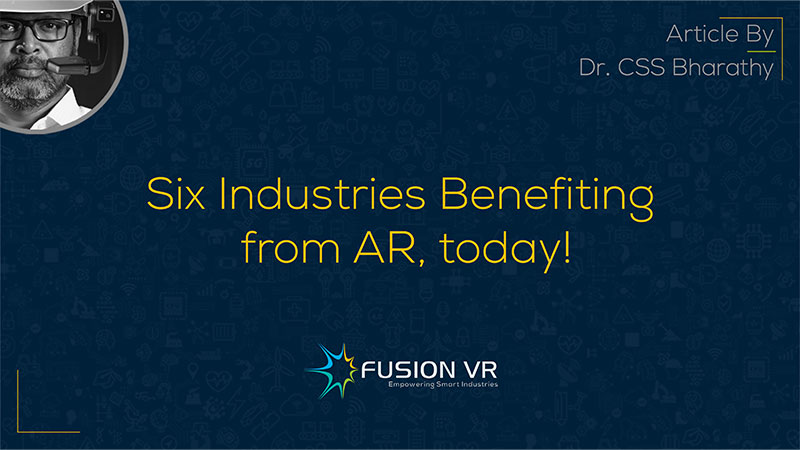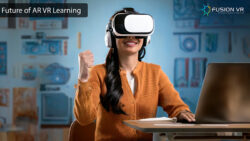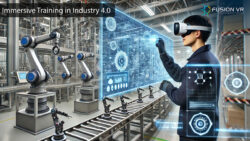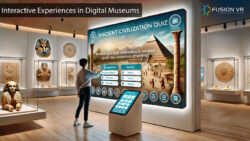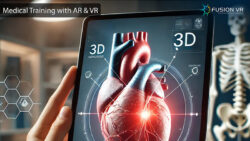It is well known that newer technologies such as VR, AR and MR are making a significant impact in several industries across the world. They are key technologies in Industry 4.0, otherwise known as the Fourth Industrial Revolution. It is extremely important that emerging economies like India begin adopting these Industry 4.0 technologies into their manufacturing companies.
This will help them ride the wave of technological changes and take advantage of the cost and operational efficiencies it creates. With everything being globalised, it creates a great competitive advantage for companies in the world markets. Let’s look at AR technology in particular and see how they are benefiting from it. Augmented reality in Industry 4.0 is poised to transform many industries. The industries that I would like to highlight in this blog are the following:
- Manufacturing
- Healthcare
- Aviation
- Construction
- Education
- Museums
Let’s begin with the manufacturing industry now. This is a great contributor to generating local employment and export revenues in addition to meeting the various needs of the people in the country. AR is helping to train personnel more quickly, efficiently and effectively than conventional training approaches, which are typically instructor led and in a classroom. This has helped employees with a shorter training duration and quicker deployment on the assembly line.
When these employees are on the job, AR solutions provide on-the-job assistance, thereby eliminating errors and quality issues before they occur. AR-powered remote assistance has enabled the provision of expert assistance from any corner of the world for troubleshooting and start-up assistance at any time of the day or night. This has helped companies reduce downtime, increase productivity and, of course, revenues.
In the world of healthcare, AR is deployed to assist surgeons with planning, rehearsing and performing complex surgical procedures. AR, coupled with established imaging technologies, is helping surgeons improve their accuracy and ensure better patient outcomes. Such results enhance the reputation of the hospital and its staff, leading to an increased inflow of patients to benefit from their services.
Augmented Reality: Enhancing Learning and Decision-making
AR is also helping with other procedures performed by nursing staff. In addition to the above, AR helps with training healthcare personnel on various procedures, enabling them to train themselves and also evaluate their performance before they do that on actual patients. AR is helping various advanced competencies in a big way. It has helped gamify and improve the engagement of the staff.
AR is increasingly deployed in Aviation with the use of AR glasses and heads-up displays. These devices and the solutions that power them provide relevant and contextual information or data to enable employees to make good decisions. These could be pilots, cabin crew or ground handling staff. Every airport employs thousands of people, and ensuring seamless communication and close coordination is paramount. As in manufacturing, AR helps in training, testing, assembly support, maintenance, quality control and remote expert assistance. Many world-class airlines, such as Singapore Airlines, have begun implementing AR in their organisations.
The construction sector is another area where AR has made a significant impact. This industry relies on drawings to ensure construction is done as per the design and in accordance with established codes and standards. Engineers no longer need to lug drawings and files to the work site.
Instead, an AR application enables them to provide the information on a tablet or goggles and also assist with the various checks to be performed. These checks are conducted with less time, and approvals are provided for the next stage of construction to progress. The end result is time and cost savings which helps achieve under-budget performance.
We have seen how AR helps in training, and the same impact is being achieved in the arena of education. The infusion of technology into our classrooms is on the rise, and institutions are eager to adopt technologies that deliver a better learning experience for their students. AR helps to understand concepts through better visualisation techniques.
Enhancing Human Performance with Augmented Reality
Students can obtain this AR experience with a school-issued tab or their own smartphone. The learning can be self-driven and monitored by assigned teachers as well. The modules are gamified, and that engages students significantly. Post-testing evaluation and student feedback enable better performance. Practical classes can be conducted with the aid of a digital assistant to guide the students.
The final industry is in the field of digital museums. Technologies like AR have delivered a completely new museum experience which is more immersive and interactive. A day at the museum would never be a boring event, trust me! Displays and interactive exhibits improve visitor engagement and appreciation for the valuable exhibits there. AR goggles enable self-guided tours with each artifact described individually, like a friend. AR superimposes digital content and enhancements, helping people get a better understanding of the important events of the past and making them more memorable.
In addition to the above six industries, there are many more that are experiencing the benefits of AR. In essence, AR helps to enhance human performance, which has a direct influence on the productivity and profitability of a company. Anyone seeking more information is encouraged to visit the Fusion VR webpage on AR. CEOs and CTOs need to deploy an increasing number of Industry 4.0 technologies to assure themselves of competitiveness and success in the 21st century.

